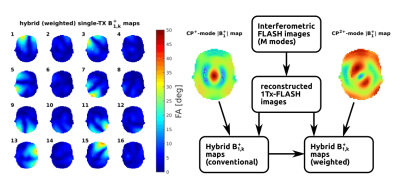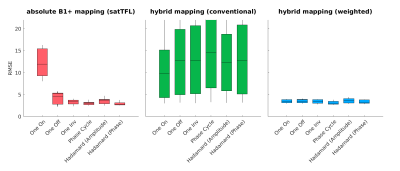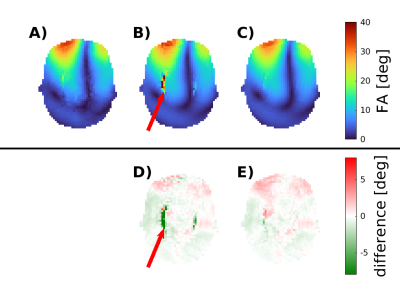2865
Interferometric, Hybrid, and Weighted $$$B_1^+$$$ Mapping for Expedited RF Calibration of Parallel Transmit Ultrahigh-Field MRI1Magnetic Resonance Center, MPI for Biological Cybernetics, Tuebingen, Germany, 2Department for Biomedical Magnetic Resonance, University Tuebingen, Tuebingen, Germany
Synopsis
With an increasing number of transmit channels, faster methods for acquiring $$$B_1^+$$$ maps on pTx MRI systems grow in importance. We compared different interferometry modes for accurate absolute $$$B_1^+$$$ mapping using satTFL. We also introduced weighted hybrid $$$B_1^+$$$ mapping as an attempt to improve hybrid $$$B_1^+$$$ mapping. In this, a second absolute $$$B_1^+$$$ map was introduced as an attempt to further shorten measurement duration while keeping acceptable accuracy. From the tested interferometry modes, phase-cycling performed best in both absolute and weighted mapping. Weighted hybrid mapping exceeded conventional hybrid mapping substantially and could therefore be sufficiently accurate for many applications.
Introduction
With a growing number of transmit (Tx) channels in Ultra-High Field (UHF) MRI the need for fast, accurate and low-SAR mapping of Tx RF-field ($$$B_1^+$$$) becomes increasingly important. Considering $$$K$$$ transmit coils $$$k$$$, the field $$$B_{1,k}^+$$$ of each transmitter consists of the magnitude $$$|B_{1,k}^+|$$$ and its phase $$$\varphi_k$$$ and is given by $$$B_{1,k}^+=|B_{1,k}^+|\cdot\,e^{i\varphi_k}$$$. For any arbitrary RF mode $$$\vec{m}=(m_0\cdot\,e^{i\varphi_0},\cdots,m_K\cdot\,e^{i\varphi_K})^T$$$ the resulting $$$B_1^+$$$ field will be $$$B_{1,m}^+=\sum_{k=1}^{K} B_{1,k}^+\cdot\,m_k$$$. Note that knowledge of the elements' phase relative to each other is sufficient for arbitrary combinations.Since the $$$B_1^+$$$ distribution of individual transmit channels often varies beyond the dynamic range of the mapping method, interferometric mapping1 is often used. In this, a set of $$$M$$$ RF modes $$$I$$$ is applied, with $$$i_{m,k}$$$ as the m-th mode and the k-th Tx element, resulting in a $$$B_1^+$$$ map subject to the RF mode: $$$B_{1,m}^+$$$. From the $$$M$$$ $$$B_1^+$$$ maps, individual $$$B_{1,k}^+$$$ fields can be determined pixel-by-pixel:
$$B_{1,k}^+(r)=\sum_{m=1}^M(I^{-1})_{m,k}\cdot\,B_{1,m}^+(r)$$
Furthermore, to expedite $$$B_1^+$$$ mapping, hybrid $$$B_1^+$$$ mapping2 can be applied. Under the assumption that received signal $$$|S(r)|\propto\alpha$$$, single transmit FLASH images (also called "relative $$$B_1^+$$$ maps") $$$S_k$$$ can be summed up to the combined image: $$$S(r)\approx\sum_{k=1}^{K}S_k(r)$$$. The same assumption allows to determine individual Tx $$$B_1^+$$$ maps:
$$|B_{1,k}^+(r)|=\{|S_k(r)|\div\,|S(r)|\}\cdot\,|B_1^+(r)|$$
In this work a saturated TurboFLASH sequence (SatTFL3) was used to acquire 3D $$$|B_1^+|$$$ maps, while $$$\varphi$$$ of any given mode $$$m$$$ was taken from unprepared FLASH images $$$S_m$$$. The performance of several interferometry patterns was compared. Interferometry was combined with hybrid $$$B_1^+$$$ mapping in order to reduce measurement time. Additionally, a second $$$|B_1^+|$$$ map was introduced to hybrid imaging in an attempt to increase hybrid mapping accuracy without increasing the required scan time too much.
Methods
All measurements were performed on a 9.4T whole-body MRI scanner (Magnetom 9.4T Plus, Siemens Healthineers, Germany) with 16 independent transmit channels, a custom built head coil (16Tx, 31Rx)4 and a head-shaped agar phantom (T1=2.6s).SatTFL $$$B_1^+$$$ mapping
SatTFL $$$B_1^+$$$ mapping was done with a 3D FLASH sequence with a rectangular preparaion pulse and strong spoiler gradients after preparation (TR=2.50ms, TE=0.73ms, BW=1000 Hz/Px, asymmetric echo, elliptical k-space acquisition, GRAPPA 2×2, FA readout=1°, FA presaturation=60°, 795 k-space lines, readout duration=1.988s, presat pulse duration=500µs, matrix size=64$$$^3$$$, resolution=3.5mm isotropic, pause between absolute maps=10s, pause between FLASH images=0.5s).
Interferometric $$$B_1^+$$$ mapping
Several sets of RF modes were used for interferometric $$$B_{1,k}^+$$$ mapping.
For determining mapping performance, $$$|B_1^+|$$$ maps of 9 randomly selected RF-modes were recorded ($$$|{B_1^+}_{ref}|$$$). The same RF-modes were applied to the measured $$$B_{1,k}^+$$$ maps and the root mean square error (RMSE) was calculated as measure for mapping accuracy.
The interferometry modes applied were (with $$$h_{n,k}$$$ being the n/k-th element of a Hadamard-matrix $$$H$$$ of order $$$M$$$ and $$$\delta_{n,k}$$$ being the Kronecker-delta):
One On: $$$i_{n,k}=\delta_{n k}$$$; One Off: $$$i_{n,k}=1-\delta_{n k}$$$; One Inv: $$$i_{n,k}=1\cdot(-1\cdot\delta_{n k})$$$; Phase-cycling: $$$i_{n,k}=1\cdot\,exp({i\cdot\,360^{\circ}\div{N}\cdot(n-1)\cdot\,m})$$$; Hadamard Amplitude: $$$i_{n,k}=h_{n,k}$$$; Hadamard Phase: $$$i_{n,k}=1\cdot\,exp(i\cdot\,180^{\circ}\cdot\,h_{n,k})$$$;
Hybrid $$$B_1^+$$$ mapping
Hybrid $$$B_1^+$$$ mapping was implemented by reconstructing single-Tx signals $$$S_k$$$ from the modes' signals $$$S_m$$$ before estimating $$$B_{1,k}^+$$$.
In an attempt to increase accuracy, a second absolute $$$B_{1,m}^+$$$ map was introduced with an additional phase shim (here $$$CP^{2+}$$$) and the corresponding $$$S_{k,m}$$$ maps were constructed by applying said phase shift to the $$$S_k$$$ images. The conversion from $$$S_k$$$ and $$$S_{k,m}$$$ to $$$B_{1,k}^+$$$ was done by weighted combination:
$$
|B_{1,k}^+(r)|=\frac{|S_k(r)|}{|S(r)|}\cdot|B_1^+(r)|\cdot\frac{|S_(r)|}{|S(r)|+|S_m(r)|}+\frac{|S_{m,k}(r)|}{|S_m(r)|}\cdot|B_{1,m}^+(r)|\cdot\frac{|S_m(r)|}{|S(r)|+|S_m(r)|}
$$
The resulting $$$B_{1,k}^+$$$ maps were tested against the randomly chosen $$${B_1^+}_{ref}$$$ maps by applying the same RF-modes to them.
Results
Fig. 1 displays the RMSEs of the $$$|B_{1,m}^+|$$$ maps calculated from the different interferometry modes and $$$B_1^+$$$ mapping methods compared to their corresponding measured maps $$$|B_{1,m}^+|$$$.It can be seen that the different sets of interferometry modes vary greatly in performance. As expected, the One On mode performed worst (RMSEs: 8.01° .. 16.29°). The lowest RMSEs were achieved by phase-cycling (2.46° .. 3.84°), followed by the Hadamard phase modes (2.53° .. 3.76°)
Conventional hybrid mapping resulted in average RMSEs over 10° for all interferometry mode sets. Introducing a second $$$|B_1^+|$$$ map as reference (weighted hybrid mapping) improved performance greatly (RMSEs in phase-cycling: 2.66° .. 3.83°).
The total recording times for interferometric mapping, conventional hybrid mapping and weighted hybrid mapping were 244s, 64s and 76s respectively.
Discussion
This study shows that $$$B_1^+$$$ Interferometry has huge advantages for multi-channel $$$B_1^+$$$ mapping. Conventional hybrid mapping delivered very poor results. A possible explanation for this finding is that $$$B_1^+$$$ inhomogeneities are very strong at 9.4T, which causes the $$$B_1^+$$$ distribution in the phantom to exceed the usable dynamic range of the sequence.By introducing a second $$$|B_1^+|$$$ map, the accuracy of hybrid mapping increased tremendously. However, hybrid mapping still could not match the performance of intrerferometric satTFL $$$B_1^+$$$ mapping.
Since $$$B_1^+$$$ inhomogeneities in-vivo tend to be lower than in the phantom used for this study, it can be expected that the weighted hybrid maps perform comparably well for in-vivo applications. Due to its extremely short acquisition time there is great potential in weighted hybrid $$$B_1^+$$$ mapping, which is why this study should be followed up by in-vivo experiments.
Experiments at different UHF field strengths, which share the difficulty of having to cope with strong $$$B_1^+$$$ inhomogeneities, are necessary to investigate how strongly the performance of the selected interferometry modes depends on $$$B_0$$$.
Acknowledgements
This project was sponsored by the Deutsche Forschungsgemeinschaft (DFG – German Research Foundation) under the Reinhart Koselleck Programme (DFG SCHE 658/12)References
1. Brunner DO, Pruessmann KP. $$$B_1^+$$$ interferometry for the calibration of RF transmitter arrays. Magnetic Resonance in Medicine. 2009;61(6):1480–1488. doi:10.1002/mrm.21893
2. Van de Moortele PF,
Snyder C, DelaBarre L, Adriany G, Vaughan J, Ugurbil K. Calibration
tools for RF shim at very high field with multiple element RF coils:
from ultra fast local relative phase to absolute magnitude B1+ mapping.
In: Proc Intl Soc Mag Reson Med. Vol 15. ; 2007:1676.
3. Bosch D, Bause J, Ehses P, Zaiss M, Scheffler K. Rapid pre-saturated TFL transmit field mapping with an optimized 3D centric single-shot readout. In: 2020 ISMRM {\&} SMRT Virtual Conference & Exhibition.
4.Shajan G, Kozlov M, Hoffmann J, Turner R, Scheffler K, Pohmann R. A 16-channel dual-row transmit array in combination with a 31-element receive array for human brain imaging at 9.4 T. Magnetic Resonance in Medicine. 2013;71(2):870–879. doi:10.1002/mrm.24726
Figures


